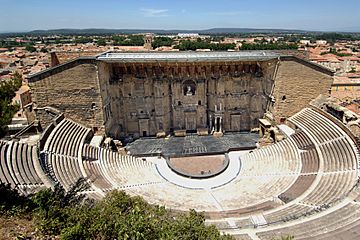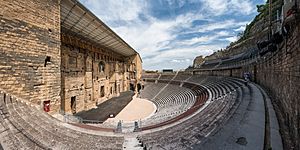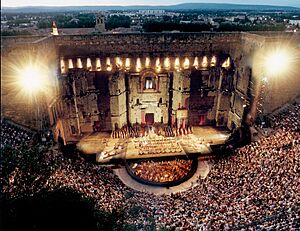Roman Theatre of Orange facts for kids
| UNESCO World Heritage Site | |
|---|---|
 |
|
| Location | Orange, Vaucluse, France |
| Part of | Roman Theatre and its Surroundings and the "Triumphal Arch" of Orange |
| Criteria | Cultural: (iii), (iv) |
| Inscription | 1981 (5th Session) |
| Extensions | 2007 |
| Area | 9.41 ha (23.3 acres) |
| Buffer zone | 116 ha (290 acres) |
The Roman Theatre of Orange (French: Théâtre antique d'Orange) is an amazing ancient Roman theater in Orange, Vaucluse, France. It was built nearly 2,000 years ago, in the early 1st century AD. Today, this incredible structure is owned by the town of Orange. It is also home to a famous summer opera festival called the Chorégies d'Orange.
This theater is one of the best-preserved Roman theaters in the world. It was a very important place for the Roman town of Arausio. This town was founded in 40 BC. The theater played a huge role in the daily lives of the citizens. They spent a lot of their free time there. Roman leaders saw the theater as a way to share Roman culture. It also helped keep people entertained and less focused on politics.
People enjoyed many types of shows there. These included mime, pantomime, and poetry readings. There were also funny plays called "attelana." Many shows lasted all day long. The common people loved exciting special effects. Grand stage sets and clever stage machinery were very important. The best part was that all the entertainment was free for everyone!
Today, the theater is used again for its original purpose. It mainly hosts operas. It is also a very popular place for tourists to visit. In 1981, the Roman Theatre was added to the UNESCO World Heritage List. It earned this honor because it is so well-preserved and has amazing architecture.
Contents
Building the Ancient Roman Theatre
Early Roman theaters were often made of wood. They were only meant to be temporary buildings. But in 55 BC, a Roman leader named Pompey built a stone theater in Rome. After that, large and permanent Roman theaters became popular everywhere. The Orange theater was built when Augustus was emperor. It is thought to be one of the first stone theaters in this part of modern-day France.
One of the most striking parts of this building is its huge outer wall. This wall is about 103 meters (338 feet) long. It stands about 37 meters (121 feet) high. Originally, there was a wooden roof over the theater. This roof protected the audience from bad weather. There is evidence on the walls that shows the roof was once destroyed by fire. Even though the wall has simple decorations, it looks incredibly powerful.
The main three doors on the first level of the wall open right onto the stage. The theater could seat between 5,800 and 7,300 people. Today, much of the seating has been rebuilt. This makes sure that tourists and audience members are safe.
The Stage and Its Back Wall
The stage is about 61 meters (200 feet) long. It is raised about one meter (3 feet) from the ground. Behind the stage is a tall wall, about 37 meters (121 feet) high. This wall is still completely preserved. It was very important for the theater. It helped to send sound to the large audience.
This wall is also known as the scaenae frons. It is the only part of the theater with detailed decorations. It used to have colorful marble designs. There were also many columns, carvings, and statues in special niches. The middle niche holds a 3.5-meter (11.5-foot) tall statue of Emperor Augustus. This statue was likely a replacement for an older statue of Apollo. Apollo was the god of music and arts.
The main door below this statue is called the Royal Door. Only the most important actors used this door to enter and exit the stage. Above the door, there was a carving of centaurs. This carving is no longer there. You can see what remains of it in the Orange Museum across the street. Today, a modern platform covers the stage. This allows the theater to be used for operas and other shows again.
The Theater's Decline
The Western Roman Empire began to weaken in the 4th century. By this time, Christianity had become the official religion. In AD 391, the theater was officially closed. The Church did not approve of what it saw as uncivilized shows. The theater was probably raided by the Visigoths in 412. Like many Roman buildings, its good stones were taken over centuries to be used elsewhere.
In the early Middle Ages, it was used as a defensive fort. By the 12th century, the Church started using it for religious plays. During the religious wars of the 16th century, it became a safe place for townspeople. This was when the town was attacked during The French Wars of Religion. Many people left Orange at that time.
Bringing the Theater Back to Life
Work to rebuild the theater started in 1825. The goal was to use the theater again for big, exciting performances. In 1869, while still being restored, the theater hosted "The Roman Festivals." More than 10,000 guests came to these events.
A very important part of the restoration happened in the 1930s. This involved digging up the area around the theater. Many old buildings nearby were also removed. This digging uncovered many historical objects and artifacts. These finds helped us learn more about the theater's history and how it was used.
Today, all three levels of seating have been fully restored. Many staircases, large parts of the floor, the stage, the orchestra area, and parts of the walls have also been fixed.
During the 19th century, the theater slowly regained its former glory. This was thanks to the efforts of Prosper Mérimée. He was the director of "Monuments Historiques" (Historical Monuments). Under his guidance, restoration work began in 1825. In 1869, the theater became home to a "Roman Festival." This festival celebrated the greatness of Rome. It included a performance of Méhul's opera, Joseph. Later in the century, many famous French actors performed at the Orange festivals. This included Sarah Bernhardt, who played "Phèdre" in 1903.
By the end of the century, the tiered seats were restored. In 1902, the festival got a new name: the "Chorégies." It was planned as an annual summer festival. The name comes from a tax that wealthy Romans paid to fund theater shows. Until 1969, the Chorégies included plays, operas, and symphonies. After that year, Orange became only an opera festival. Plays were then performed in Avignon.
What the Theater is Used For Today
The Théâtre d'Orange is considered the best-preserved Roman theater in all of Europe. It is managed by Culturespaces. This organization also looks after other cultural sites nearby. These include the Orange Museum and the Triumphal Arch. This effort helps keep the theater safe. It is used as both a historical site and a place for concerts and plays.
The first big festival held in the theater after restoration began was in 1869. It was called "The Roman Festival." This festival grew into the annual Chorégies festival. These events use multimedia and attract thousands of visitors from all over the world.
During the rest of the year, the Théâtre d'Orange is a major tourist spot. Visitors can walk through the main theater. They can also explore the surrounding rooms and hallways. An audio guide helps them learn about the site.
In 1981, UNESCO officially named the theater a World Heritage Site.
Gallery
-
The centaur frieze
See also
 In Spanish: Teatro romano de Orange para niños
In Spanish: Teatro romano de Orange para niños
- List of Roman theatres
- List of opera festivals









